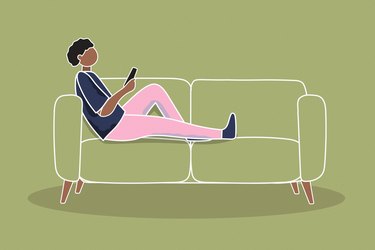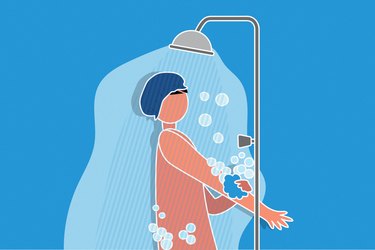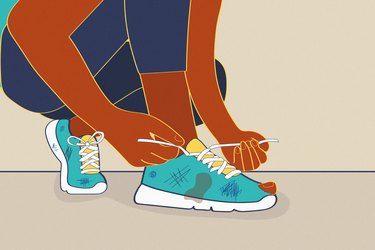
When the novel coronavirus pandemic hit, people around the globe unhooked their strapless, padded and pushup bras, and chose to maximize comfort over structure. If they didn't set the twins completely free by going braless, they slipped on bralettes, leisure bras or, most popular of all, sports bras.
And although sports bras went viral during COVID, they were been on the rise long before words like "coronavirus" and "N95" ever crossed our lips.
Video of the Day
Video of the Day
An August 2019 report from market research company The NPD Group found that the number of people shopping for sports bras rose from 38 percent in 2015 to 45 percent in 2018, and sports bra sales made up more than a quarter of total bra sales.
What's more, they're no longer exclusively for the gym, jogging path or spin studio. Many people slip on a sports bra when hanging around at home or running errands, and nearly a quarter wear them to work.
But could wearing sports bras 24/7 sabotage the health or appearance of your tatas? Some people claim they lead to issues like sagging, soreness, breakouts or even breast cancer.
We did some digging and found out what you do and don't need to stress about. If you live in your sports bra, this is a must read.
The 3 Biggest Sports Bra Myths
First, the good news: Some of the downsides you might have heard about sports bras don't hold water.
Myth 1: They Make Your Breasts Droop
No way. If anything, they might keep you perkier for longer.
"The breast can change shape over time due to structures [in breast tissue] called Cooper's ligaments — these are like rubber bands that help give lift and support, and which become more lax as we age," says Roshani Patel, MD, breast surgical oncologist at Dartmouth-Hitchcock. "Anything that causes stress on the Cooper's ligaments can alter their shape."
The prime example of this is free-boobing, or wearing a bra that's not supportive enough so that your breasts hang down, stretching out these ligaments.
Because sports bras generally offer more support than a regular bra, we asked Dr. Patel whether they might actually help prevent breast sagging: "Theoretically and logically, the answer would be yes," she says. "But there is no clinical data on this."
Myth 2: They Cause Breast Pain
Nope. "There is no good clinical data to show this," Dr. Patel says. Rather, well-fitting sports bras are linked to greater breast comfort.
"Underwire bras can give more of a lifted appearance, but not all underwire bras give good support — as a result, if someone has a larger breast size, this can cause stress on the muscles that sit behind the breast (the pectoralis muscles) and cause pain," Dr. Patel says. "Many patients who see me for breast pain switch to wearing a sports bra or bra with stretchy material because they feel as if they have better support."
Myth 3: They Give You Breast Cancer
There's zero truth to the theory that the extra pressure from a tight sports bra can prevent your body from releasing toxins, leading to disease. "Wearing a sports bra all the time does not compress the lymph nodes or cause cancer," Dr. Patel says.
In fact, she actually recommends a compressive bra to people with breast cancer to help prevent breast lymphedema (swelling of the breast due to poor lymphatic drainage) after surgery and radiation.
But Sports Bras Can Lead to Skin Issues
Sports bra addicts might experience breakouts. Here's why: If you sweat in a sports bra — whether from exercise or summer heat — and don't change afterward, perspiration accumulates on both your skin and the material.
"When the sweat dries, it leaves behind mineral salts, including sodium, potassium and chloride," says dermatologic surgeon Teo Soleymani, MD, health sciences clinical instructor at UCLA Health.
Have you ever noticed a white lacy residue on your sports bra after exercising? That's mineral salt. "Mineral salts can be quite irritating to your skin," Dr. Soleymani says. You might notice pimples or a rash in the folds of your breasts, between your cleavage or under your arms.
To stave off mineral salts, don't hang out in a sweaty sports bra. Wash it post-workout and whenever it stinks.
"An odor can indicate that sweat has saturated the material or that there is bacteria growing on it," Dr. Soleymani says. (If you don't sweat very much and haven't exercised in it, you can wear it a few times before throwing it in the machine.)
It also helps to choose fabrics that breathe or are moisture-wicking. "Especially if you are prone to rashes or breakouts, stick to 100 percent cotton," Dr. Soleymani says.
Many of the latest-and-greatest sports bra materials, such as neoprene, are designed to be super supportive and pliable — but they don't remove moisture well. Plus, a small percentage of people have a skin allergy to neoprene.
Wearing a too-tight sports bra opens the door to a bunch of other skin problems. Among them: irritant dermatitis, a rash caused by repetitive friction; and acne mechanica, zits induced by heat and rubbing.
Folks with sensitive skin or who tend to get acne or eczema are at greater risk for sports bra-related reactions.
"We all have natural bacteria that lives on the surface of our skin, called the microbiome," Dr. Soleymani says. "But when you wear something occlusive that rubs tightly against your body, like sports bras do, that surface bacteria is pushed down into your hair follicles, which is where acne starts."
If you have existing skin issues, you might be better off only wearing a sports bra during exercise. The rest of the time, don a sleep bra (like this one, from Skims) — it's soft and comfy, but looser-fitting and breathable.
And They Might Cause Problems if You're Breastfeeding
Nursing parents, heads up: If your sports bra is tight as heck or you wear it at night, it can trigger a drop in milk supply. "It can put too much pressure on the milk ducts, clogging or slowing the flow of milk," says Leigh Anne O'Connor, an International Board-Certified Lactation Consultant based in NYC and vice president of the New York Lactation Consultant Association.
Not only might your baby get less to drink, but it can sabotage your breast health, too. The backed-up milk can create a plugged duct, which manifests as a tender, red, engorged area of the breast.
"Chronic plugged ducts can lead to mastitis, an infection of the mammary tissue," O'Connor says. "If left untreated, it could lead to a breast abscess." Along with breast pain and redness, mastitis often causes fever-like symptoms.
But you don't need to ditch your sports bra altogether. "If the sports bra fits properly, it can be worn all day," O'Connor says, "Although I caution against sleeping with it."
In addition to a good fit, look for a sports bra specifically designed for BF parents.
"Breathable fabric with an easy-to-use flap or hook for easy access to the breasts is good," O'Connor says. "The bra should not be too tight or have underwires."
She also reminds folks to change if your bra gets sweaty or damp while nursing, to avoid a possible yeast infection under the breasts.
Can You Wear a Sports Bra to Bed?
Unless you're breastfeeding or having skin problems, experts agree it's OK to sleep in your sports bra. But to be on the safe side, you might want to put on a fresh one before you hit the hay.
"Using the same bra day and night can result in rashes and fungal infections," Dr. Patel says.
And think about switching to a less-restrictive style that will let the girls breathe. "Consider one with light compression, or a lightly compressive camisole [that has a built-in shelf bra]," Dr. Patel says. (We like this one from Hanes.)
3 Types of Sports Bras
Each works a bit differently. Read on to learn which one is right for you.
1. Compression sports bra: This is your classic sports bra, where a band of stretchy fabric presses your breasts against your chest to restrict movement. It can be a good option if you have small or medium breasts.
2. Encapsulation sports bra: Bye-bye, uniboob! The encapsulation style looks more like a regular bra, with a separate cup for each breast. If you want to give the girls a lift, this might be the bra for you. “Built-in cups with support at the bottom [like molding or underwire] can help,” Dr. Patel says.
3. Combination sports bra: A compression-encapsulation hybrid, it raises up and supports each breast individually, and has a panel of tight material across the top to minimize bouncing. An August 2012 study in The Research Journal of the Costume Culture found that the combination style was the comfiest for larger-chested people. “Wider breasts may require more lateral support,” Dr. Patel says. Combo bras hug your rack in on the sides.
How to Find the Right Bra for You
Especially if you're on the busty side, tracking down a sports bra that fits like a glove is so crucial, yet sometimes elusive.
A March 2019 study in The Journal of Science and Medicine in Sport found that people with large breasts participated in significantly less physical activity (particularly vigorous activity) than those with smaller breasts. Around half of them reported that the size of the girls affected their exercise routine. This syncs up with findings in a January 2014 British Journal of Sports Medicine study, where 32 percent of marathon runners assigned female at birth (AFAB) experienced breast pain (most of those who did were well-endowed.)
"It is a common misconception that sports bras should fit tightly," Dr. Patel says. "They can hurt if there is too much compression used over a prolonged length of time, so if the breasts feel too flattened with a bra, it is probably not a good one."
On the other hand, your tatas can feel tender if they lack support. "Bras that are not supportive will allow the breasts to "bounce" too much," Dr. Patel says. "Like the story Goldilocks, the compression should be 'not too much, not too little, but just right.'"
Going to a store to be professionally fitted for a sports bra is your best bet. A specialist will assess what would work well for your body and lifestyle. Otherwise, this interactive tool developed by Breast Research Australia, a research institute associated with the University of Woolongong, can help you determine your correct sports bra size. And whether you're shopping in person or online, make sure you try on a bunch of styles before buying.
Related Reading
8 Signs Your Sports Bra Doesn’t Fit Right
If any of the following are true for you, it's time for a shopping trip, per Breast Research Australia.
- It's not comfortable or leaves red marks on your skin. The straps and band should be snug but not too tight.
- The underwire or bottom band sits on your breast tissue, rather than your rib cage. (Try a different size or style.)
- If you have an encapsulation or combo bra, there is a gap between the center front panel (between your breasts) and your skin. The fabric should lie flat against your breastbone.
- Your breasts bulge out the sides or top. If this happens, size up.
- It rides up or moves forward when you lift your arms overhead. This means you need a smaller bra.
- The fabric is wrinkly or there are gaps between the fabric and your skin. (The bra is too big.)
- If you look at yourself in the mirror, the back of the band is higher than the front. (Go down a size.)
- The straps slide off. A December 2015 study in Sports Medicine-Open found that wide, vertical straps were the most comfortable for folks with a large bust. "If you have wide shoulders, a racerback may be better," Dr. Patel says.
- Your breasts hurt or bounce when working out. In that case, you might require more support or a different style.
How to Put on a Sports Bra
Once you've nailed the fit, make sure you're putting it on correctly. (Most people aren't.)
According to Breast Research Australia, you should:
- Attach a new sports bra on the loosest clip. Because they stretch out with wear, you'll squeeze more life out of your bra if you start on the loosest setting and tighten it up over time.
- Hold down the band with one hand. With the other, scoop up each breast and swoop it toward the center of the cup so that all of your breast tissue is in the cup. Make sure the band is against your ribcage rather than your actual boob.
- Check the straps and adjust them if needed.
So, How Bad Is It Really to Wear a Sports Bra All the Time?
Unless you're breastfeeding or have sensitive, acne-prone skin, it's fine!
"In my opinion, it is not bad to wear a sports bra all the time if it is comfortable and gives good support," Dr. Patel says.
Just keep tabs on your skin. "If you notice breakouts, rashes, itching or chafing [around the bra area] that you didn't have before, that's a sign you might be wearing it too much or that it's not the right fabric for you," Dr. Soleymani says. "But if you wear it all day long and love it, then rock on!"
- Sports Medicine-Open: "Bra strap orientations and designs to minimise bra strap discomfort and pressure during sport and exercise in women with large breasts"
- The Research Journal of the Costume Culture: "A Study on Comfort of Sports Bras by Style and Bra Cup Size"
- The Journal of Science and Medicine in Sport: "Does breast size affect how women participate in physical activity?"
- British Journal of Sports Medicine: "The experience of breast pain (mastalgia) in female runners of the 2012 London Marathon and its effect on exercise behaviour"
- NPD: "Shopping for a Bra is More About Comfort Than Sexiness, Reports NPD"
Is this an emergency? If you are experiencing serious medical symptoms, please see the National Library of Medicine’s list of signs you need emergency medical attention or call 911.



